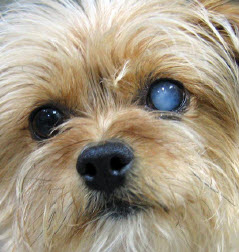Cataracts are a condition affecting the eye that many people
may be familiar with due to its prevalence in humans. The eye itself is a
fairly complex structure however cataracts only affect one part, the lens. The
lens is used to focus the eye on a specific image. Cataracts are a distinct
opacity on the lens that affects vision. It can encompass a small part of the
lens or the entire lens. If the entire lens is affected the patient will be
blind in that eye. There is another condition that can affect the lens called
nuclear sclerosis. This is just a clouding that occurs on the lens as pets age.
They are still able to focus and see through this area where as cataracts they
cannot.
 |
| In this pet only the left eye is affected with the cataract. (Image Source) |
There are several ways pets can develop cataracts. One is
that they could be born with the condition. Many times this will only be a
small portion of the lens so they can still retain some vision in that eye.
There is also a genetic link to cataracts so if purchasing a puppy it is a good
idea to make sure the parents have had their eyes checked by a veterinarian.
Another cause is diabetes. Almost every dog with diabetes will develop
cataracts at some point in their life.
 |
| Surgical correction is an option for some pets but will require a full work up to ensure they are a good candidate (Image Source) |
Cataracts by themselves do not cause any serious issues
(aside from loss of vision). However as they progress or if any movement of the
cataract occurs, it can lead to pain and inflammation. In some cases the
cataract can block fluid from leaving the eye which can cause a secondary glaucoma
( a spike in the pressure in the eye) which is extremely uncomfortable. If your
pet has cataracts regularly checkups with your veterinarian will be a good idea
as well as monitoring at home to make sure your pet remains comfortable will be
important.
There is a treatment for cataracts which involves surgically
removing the defect. However this can be very invasive and not all patients are
good candidates. Many times this will require referral to a veterinary ophthalmologist
to determine if surgery is a good idea for your pet. Most owners elect
management. This means actively monitoring for any secondary side effects
(increased pressure, redness or inflammation) and treatment them before they
get out of hand. Although it does affect their vision, many pets will adapt to
the decreased eyesight especially if it is a slower onset. IF rapid blindness
occurs, behavioral modification may be necessary to make sure your pet feels comfortable
and safe now that they have lost one of the senses. For more information on cataracts please visit
the following website
here.




Do Ethosheaven Bright eyes drops work for dogswithcataracts
ReplyDeleteThat's a great question! This is not a product I can say I have ever used. As far as I know there is no drop that is guaranteed to help fix cataracts. Surgery is the only way to correct it. There are medicated drops that will help keep the eye comfortable if there is any secondary inflammation or pressure issues.
ReplyDelete